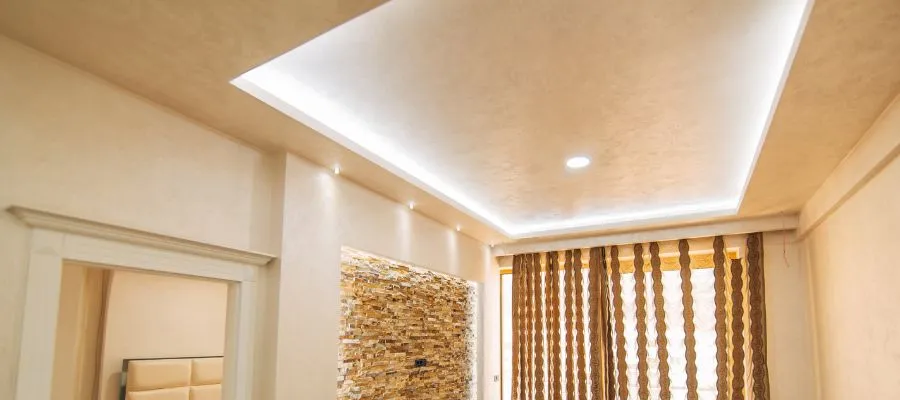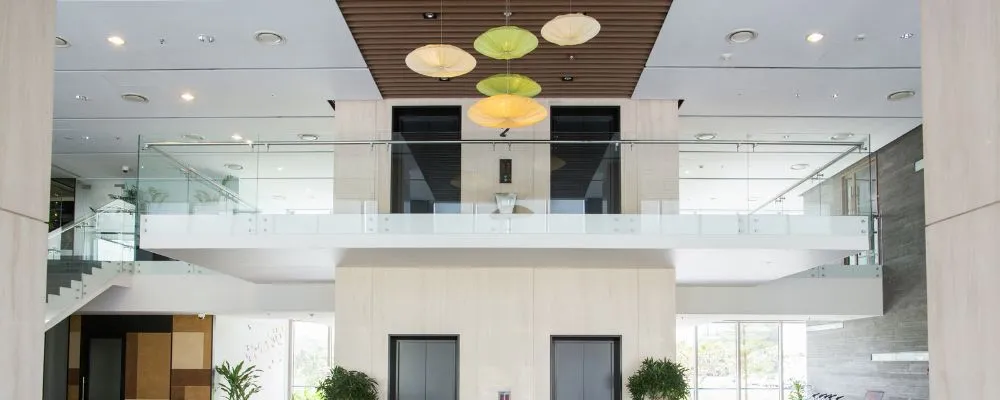In modern interior design, false ceilings are an important part of making places look better and work better. They can be used in homes as well as companies. Understanding the different types of false ceiling materials can help you make a choice that fits your needs and preferences. In this blog, Brick & Bolt talk about the false ceiling materials, including the advantages and disadvantages of each.
What is a False Ceiling?
A false ceiling, also called a dropped or suspended ceiling, is an additional ceiling that is put up below the room’s main ceiling. It improves the sound quality, hides wires and ductwork, and makes the room look better, among other things. Using false ceiling materials can have a big effect on how the ceiling works and looks.
Different Types of False Ceiling Materials

A false ceiling comes in a number of various designs that meet different design interests and practical needs. Each type is different because of the material that was used to make it. Here are some common types of false ceiling materials:
- Plaster of Paris (POP) False Ceiling Material
- Wooden False Ceiling Material
- Gypsum False Ceiling Material
- PVC False Ceiling Material
- Glass False Ceiling Material
- Metal False Ceiling Material
- Fibre False Ceiling Material
1. Plaster of Paris(POP) False Ceiling Material
Plaster of Paris (POP) is the most popular material used to make false ceilings. This material sets quickly and is made of calcium sulfate hemihydrate, a fine white powder that forms when it gets wet and is left to dry. It’s economical, lasts a long time, doesn’t get worn down quickly, and is easy to find. POP is great for any style because it can be changed to fit your needs. It can be moulded into both simple and intricate designs. It is flexible, unlike gypsum, and can be easily put up in corners.
Advantages of POP False Ceiling Materials
- POP false ceilings have a smooth, seamless finish that can be moulded into various designs.
- POP isn’t too expensive when compared to other false-ceiling materials.
- For both hot and cold regions, POP is a good choice because it provides good thermal insulation.
Disadvantages of POP False Ceiling Materials
- Over time, cracks can appear in POP false ceilings.
- To keep their overall appearance, they need to be taken care of regularly.
- POP isn’t good for places with a lot of heat because it can soak up water and break down.
2. Wooden False Ceiling Material
Wood is often used in false ceiling designs to complement POP designs or to make ceilings look more interesting. Wood can be a structural part of a design or just something that looks nice. Finishes like laminates or veneers can also be added to the false ceiling to make it look and feel more expensive and rich. With soundproof wooden walls, this material offers many great ways to keep noise out of a room.
Advantages of Wooden False Ceiling Materials
- Wood has a rich, natural look that makes the design look better as a whole.
- High-quality wood is strong and can last for a long time
- Wood is a good insulator for both sound and heat.
Disadvantages of Wooden False Ceiling Materials
- Compared to other false ceiling materials, wooden ceilings can be expensive.
- They must be maintained regularly to avoid problems like termites and cracking.
- Wood can catch fire, which is not good for safety.
3. Gypsum False Ceiling Materials
Nowadays, gypsum is the most popular false ceiling material. It comes in the form of square boards that are made in a factory-manufactured. A lot of people use gypsum as a false ceiling material because they are versatile and have a smooth finish.
Advantages of Gypsum False Ceiling Materials
- Gypsum can be used in a variety of designs and finishes.
- Gypsum is non-combustible, which makes it a better choice.
- Gypsum boards are lightweight and easy to install.
Disadvantages of Gypsum False Ceiling Materials
- Gypsum can be more expensive than other false-ceiling materials.
- Gypsum shouldn’t be used in places with a lot of humidity because it can soak up water and become weak.
- It can be hard to fix damaged gypsum ceilings without leaving any gaps.
4. PVC(Polyvinyl Chloride) False Ceiling Materials
Polyvinyl Chloride is a type of plastic material that can be used in many ways. PVC materials are known for lasting a long time and do not need much upkeep.
Advantages of PVC False Ceiling Materials
- PVC is resistant to moisture, termites, and mould.
- The PVC ceilings are easy to clean and maintain.
- PVC isn’t too expensive and offers good value for your money.
Disadvantages of PVC False Ceiling Materials
- PVC might not have the same high-end look as other false ceiling materials like wood or gypsum when it comes to looks.
- Production and disposal of PVC can have negative effects on the environment.
- When PVC is burned, it can give off poisonous fumes.
5. Glass False Ceiling Materials
If you want more light to spread out, glass materials are a good choice for a false ceiling. Because it is transparent, the light from the recessed lighting can shine through it without any problems.
Advantages of Glass False Ceiling Materials
- Glass ceilings can make a room feel bigger and brighter.
- Glass ceilings can be changed to fit different designs because it comes in many colours and finishes.
- Good toughened glass is strong and lasts a long time.
Disadvantages of Glass False Ceiling Materials
- Installing a glass ceiling can be pricey.
- To keep their look, they need to be cleaned regularly.
- Glass can break easily, which can be dangerous.
6. Metal False Ceiling Materials
Metals are popular for modern designs because they look shiny and smooth. A false ceiling made of metal can be used as tiles, boards, or panels. The two most popular types of metal used for false ceilings are aluminium and galvanised iron.
Advantages of Metal False Ceiling Materials
- Metal ceilings last a long time and don’t get damaged easily.
- It is fire-resistant, which makes it safer.
- They’re simple to clean and maintain.
Disadvantages of Metal False Ceiling Materials
- Metal ceilings can be pricey.
- They may not provide good sound insulation.
- The industrial look of metal might not go with all types of indoor designs.
7. Fibre False Ceiling Materials
Fibre false ceiling materials are made of a mix of both synthetic and natural materials, like wood, tar, asphalt, vegetable fibre, etc. The fibres that come from natural things make the material stronger. Natural fibres are the best building insulation materials. Hence, they have amazing soundproofing properties.
Advantages of Fibre False Ceiling Materials
- They do an excellent job of blocking out noise.
- These materials are fire-resistant.
- These ceilings are cost-effective.
Disadvantages of Fibre False Ceiling Materials
- They may not offer the same visual appeal as other false-ceiling materials.
- Mineral fibre can get damaged by water and direct contact, such as rubbing or hitting something.
- To keep their sound quality, they need to be serviced regularly.
In conclusion, choosing the right false ceiling materials can make a big difference in how it looks and how it works. Knowing the advantages and disadvantages of each material will help you make an informed choice, whether you want the classy look of wooden false ceilings, the long-lasting strongness of PVC false ceilings, or the sleek modern look of glass false ceilings. When choosing the best false ceiling materials for your project, don’t forget to consider costs, upkeep, and space needs. If you are planning to construct your home, then contact the best leading construction company in Delhi and make your dream come true.

